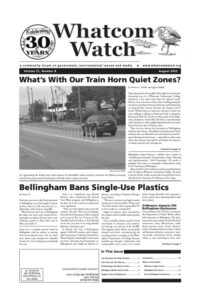by Jayne Freudenberger
This photo initially appeared in the June 2012 issue of Whatcom Watch. It shows a Nissan LEAF at the Sehome Village charging station. The two-part article by Ken Carraso was about his first 8,000 miles in a petroleum-free Nissan LEAF. photo: Ken Carraso
The recent tsunami of Supreme Court decisions that will change some fundamental rights of this country has caused anger on many fronts. For environmentalists, the idea that the Environmental Protection Agency (EPA) has no authority to make laws concerning certain regulations is particularly concerning.
The Supreme Court said that the executive branch could not delegate important decisions to appointed agencies because these decisions are the responsibility of Congress.
We are staring at the daily destruction of our planet and now must wait while a Congress that cannot come up with majority votes on anything and who lacks the expertise and time to study issues, holds our planet in its hands. What’s an environmentalist to do? Disgust is allowed, but not inaction.
There is no question that this ruling (as well as those already being eyed by the court for next year) will make our work on climate harder. The one good spot of the court’s decision is that it did not gut the EPA.
The decision was narrowly made on the cap and trade proposal for West Virginia’s coal mines. What is interesting is the state itself was a litigant on the anti-side of this and even the EPA was already moving on to more viable climate mitigation.
The controversy might linger into the next session as the conservative court seeks to “deregulate.” As discouraging as this decision was, there are encouraging signs in many ‘mitigation” efforts that will continue, and our mission is to buckle up for the arduous road ahead and champion these efforts, especially in our own state. While national action is preferred, states are where the action is likely to be.
Working Toward Carbonless Future
Here in Washington, we are lucky to have a governor and legislature that are working relentlessly on mitigation efforts. Encouraged by Gov. Inslee, the SBCC (Washington State Building Codes Council) voted to approve changes to its energy code that will require all-electric space and water heating in new commercial buildings by 2023, a big step toward decarbonization. Other states, including California, are making similar rules. Buildings and transportation are the two biggest contributors to carbon emissions; they should be priorities as we work toward a carbonless future.
Market forces are leaning toward electric cars. The success of Tesla has encouraged the already burgeoning market for electrical vehicles (EVs). Global EV sales topped 6.4 million units sold worldwide in 2021, and, this year, the market for electric vehicles is being encouraged by the high price of gasoline. The only limit to manufacturing them seems to be the shortage of some of the rare minerals used in batteries and electronics, but a limit to buying EVs is the worry people have over the range. There is good news on that front.
Solid Power, a Colorado company, is developing solid-state batteries for their partners Ford and BMW. They have just completed the installation of a pilot production line to make about 300 battery cells a week. The design makes batteries that weigh less and hold much more energy than conventional liquid batteries; this will enable a large increase in the range of EVs.
All the major manufacturers are making big investments for an EV future, including even the personal pickup truck market. The Ford 150, which is their most popular vehicle, is now available only as an EV; currently, it has a waiting list to buy it. Surprisingly, the less well-known Rivian pickup has outstripped the F150 in sales, proving there is healthy competition in this area.
The Build Back Better bill included $7.5 billion for charging stations; however, it was blocked by Republicans and Joe Manchin. Many are urging President Biden to use his executive authority to pass some of the green energy provisions. It would seem to behoove major manufacturers of automobiles to lobby for the charging station provision and perhaps that will happen after the midterms.
West Coast Green Highway
Meanwhile, Washington state officials have already worked on building up the state’s EV charging station infrastructure. This effort is in conjunction with growing the West Coast Green Highway, the 1,350-mile stretch of I-5 from the Canadian to the Mexican border through Washington, Oregon, and California. It’s also part of a powerful charging network for drivers traveling the 276 miles of I-5 between Washington’s borders with Canada and Oregon.
With a better battery and more charging stations, there really is little reason not to relinquish your gas guzzler; and remember, until the end of the year, there are still good monetary incentives to exchange your gas furnace for an electric heat pump and solar panels.
______________________
Jayne Freudenberger is cochair of the League of Women Voters Bellingham/Whatcom County Climate Issues Committee. She has lived in Bellingham for 50 years, almost qualifying her as a native.




























